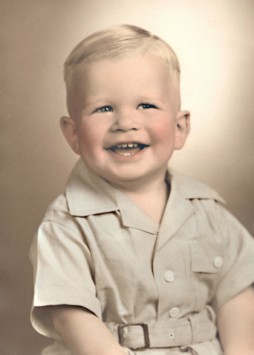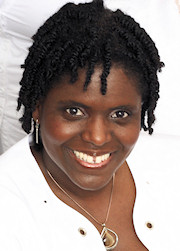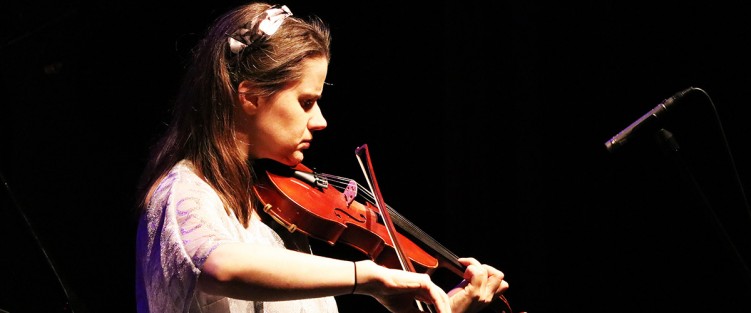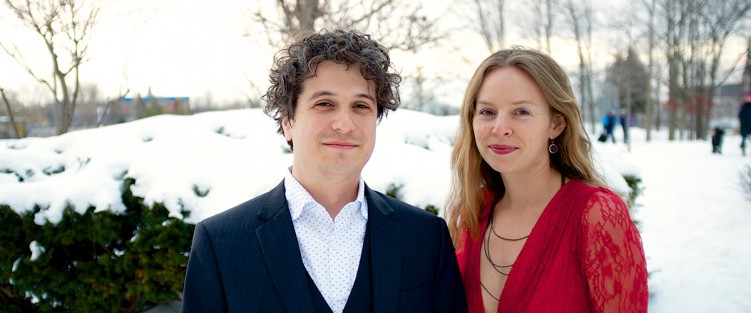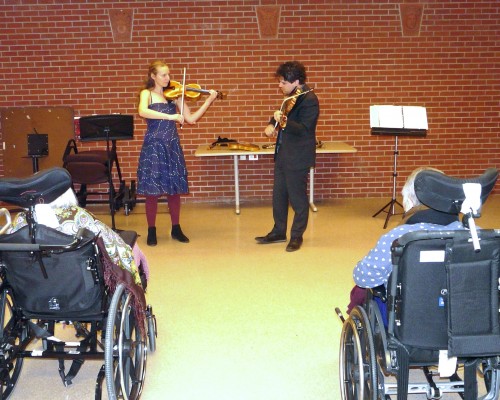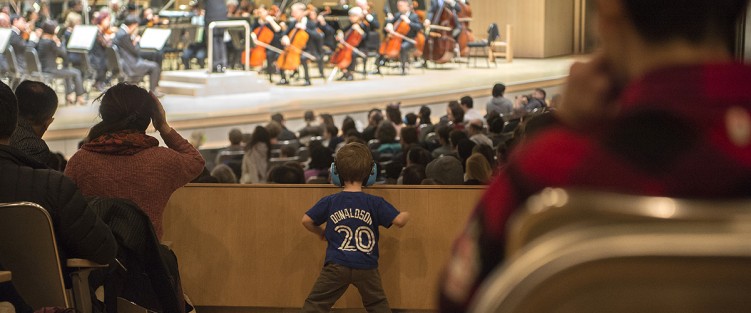 Roy Thomson Hall is humming today as parents, children and an autism service dog troop in to the Toronto Symphony Orchestra’s matinee performance of “Let’s Dance,” featuring moves from ballet to hip-hop.
Roy Thomson Hall is humming today as parents, children and an autism service dog troop in to the Toronto Symphony Orchestra’s matinee performance of “Let’s Dance,” featuring moves from ballet to hip-hop.
Most make a beeline for the Resources Table, stacked with goodies. There are sunglasses in funky pink, orange, green and yellow; headphones; ear plugs; and hair spirals to stretch when you’re anxious. All of these help to channel arousal.
A gangly, soft-spoken tween and his mother join the swarm. Michelle Saunders is excited about the upcoming show but isn’t sure her son will last through it all. Emerson loves music, but struggles to block out ambient noise and focus on the tunes, says Saunders. Sometimes he shuts down, and the pair have to leave. It’s tough emotionally and financially for both. “But as a parent of a kid with autism, you get used to abandoning plans,” she says.
Emerson may or may not make it to the end today. “But in this environment, that’s OK,” says Saunders. He grabs some ear plugs, while his mother scoops up a fidget toy shaped like a musical note to tone down her own tension. “Just in case,” she says. Fortified with the freebies, they head into the auditorium.
It is April 27, 2019 and this is the Toronto Symphony Orchestra’s first Relaxed Performance, geared towards people living on the spectrum, or anyone with sensory or communication sensitivities. These shows feature a laid-back atmosphere, where spectators’ issues are addressed so they can relax and enjoy themselves.
Hypersensitivity to sensations is one of these issues. Those who live with autism have unique ways of processing signals from the environment, says Relaxed Performance consultant Rachel Marks, who worked with the TSO to shape today’s recital. Many have trouble filtering out extraneous stimuli from those they’re trying to concentrate on. The barrage of sensory input from typical concerts can be so overwhelming and anxiety-provoking that many people on the spectrum will forego these occasions.
But nerves aren’t the only problem. Parents of typically developing children often make snap judgements when a child on the spectrum has a meltdown from sensory overload. “They make not-so-friendly comments about the ‘bratty kid,’” says Marks. Caregivers wanting to shield their loved ones from these negative comments avoid public places like theatres.
Relaxed Performances began in the United Kingdom in response to these concerns, and have spread to theatres across Canada, including Mirvish Productions, Soulpepper, Stratford and Young People’s Theatre. Some shopping malls and restaurants are also sensory-friendly, offering periods of reduced sound and lighting. “People are becoming more open and inclusive,” says Marks.
Relaxed Performances accomplish this goal by tuning in to the audience’s concerns. Detailed guides, for instance, available long before the show, allay fears about the future. These visual aids reassuringly lay out the nitty gritty details of the upcoming experience, from where to park to who will take your ticket. “A prepared person is more confident,” says Marks.
Reducing the sensory stimulation also helps patrons on the spectrum to unwind. Anyone wishing to retreat from the noise can relocate to the unbooked back rows or escape to a quiet room equipped with colouring books, modelling clay and other soothing activities.
Self-expression is another aspect of the new project. Many children on the spectrum have developed unique ways of coping with anxiety, including vocalizing or performing repetitive actions like rocking or flapping their arms, says Marks. In addition to these actions, called stimming, some children living with autism have coexisting attention deficit disorder, which provokes constant motion. While these behaviours are frowned on during traditional concerts, they’re expected at Relaxed Performances.
Parents benefit from these concessions as much as the children. It’s comforting to know that everyone is there for the same reason, says Marks. “They’re able to enjoy that moment so much more because they’re not worried about inconveniencing other families.”
Today’s Relaxed Performance is an extension of the Toronto Symphony Orchestra’s general commitment to accessibility, says Aaron McFarlane, director of education and community engagement. The orchestra has the largest outreach to elementary students in Canada. It’s also long offered accessible seating, assisted hearing devices, back supports, and accommodations for service animals.
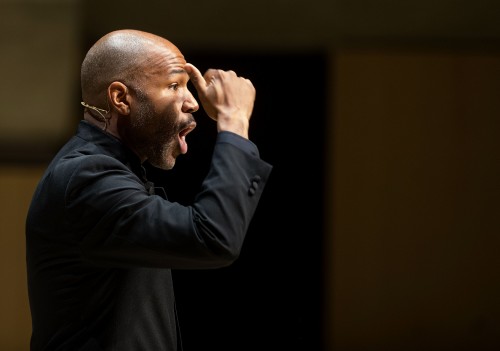 Last year the TSO pooled their expertise on the Relaxed Performance and set the date for its premiere. McFarlane had experience working with children on the spectrum, while guest conductor Daniel Bartholomew-Poyser was a veteran of the relaxed initiative. McFarlane consulted a series of experts on autism (including Rachel Marks) and reached out to over 75 community groups serving neurologically diverse children, rapidly selling out the show’s over 800 seats.
Last year the TSO pooled their expertise on the Relaxed Performance and set the date for its premiere. McFarlane had experience working with children on the spectrum, while guest conductor Daniel Bartholomew-Poyser was a veteran of the relaxed initiative. McFarlane consulted a series of experts on autism (including Rachel Marks) and reached out to over 75 community groups serving neurologically diverse children, rapidly selling out the show’s over 800 seats.
Those who missed out on a ticket needn’t fret. “I see this as a transition to one day when all performances will be accessible to those with sensory issues,” says McFarlane.
Bartholomew-Poyser is equally dedicated to the enterprise. Face beaming, he strides to the front of the stage and invites the crowd to feel at home – they can vocalize, flap their arms, or dance in the aisles. “You’re welcome to take care of your needs,” he says. The audience cheers.
Bartholomew-Poyser is clearly in his element. He’s been conducting Relaxed Performances with the Thunder Bay Symphony Orchestra since 2012. They got positive feedback after the first one, and developed a large and loyal following for subsequent spinoffs. “Both children and parents were so grateful to have a place to come without fear of judgment,” says the conductor.
Bartholomew-Poyser is tinkering just a little with today’s numbers. He’s toning down the percussion section and also warning the audience of any sudden loud noises. “There will be no surprises,” he promises. But most importantly, he’s making the spectators feel safe under his wing.
Saunders and her son are both touched by the conductor’s attitude. Emerson is used to environments where he has to work so hard to stay still that he can’t appreciate the show. “For him to know that he could enjoy himself – that was a child balloon,” says his mother.
The conductor’s words are equally reassuring for Saunders. “Normally in performances I have to put a hand on his knee to remind him to calm his body and quiet his voice,” she says. But not today. “We’re both relaxed – that’s the beauty of it.”
It seems like the other spectators are equally at ease. They’re singing, rocking, and running up and down the aisles. One girl stands up and pretends to conduct.
As the concert progresses, kids skip down to the front row, where they twirl and bounce alongside the professional dancers. One teenager with a grey hoodie makes an impromptu debut, leaping onto the stage where he kicks his long legs in perfect tandem with the lithe Irish jiggers. He ignores his caregiver who’s frantically beckoning to him.
Emerson is intrigued by the boy’s bravado, watching the breakout star with wide eyes as the tween wriggles around in his seat. The younger boy worries that the show crasher is headed for trouble. But when the teen hops gracefully back to the floor at the end of the number, the auditorium erupts in applause. Emerson joins in, relieved. “Nobody freaked out – everyone enjoyed it,” says Saunders. “That’s what a Relaxed Performance is all about.”
The children’s joyous reaction to today’s music doesn’t surprise professionals in the field of autism. Many individuals on the spectrum are musically gifted, says Rachael Finnerty, psychotherapist, music therapist, and founder of the Ontario Music Therapy Academy. According to one study, kids on the spectrum had better pitch, rhythm and recollection for melodies than their typically developing counterparts.
This natural aptitude can be harnessed to address verbal and non-verbal communication difficulties, which are common in this population, says Finnerty. Many children living with autism are uninterested in conversing, and produce stilted learned phrases rather than off-the-cuff answers.
Music, however, is an alternate language. Like the spoken tongue, it has its own set of rules – passages often echo each other, and harmonic structures give phrases predictable endings, says Finnerty. The give and take of improvisational music simulates the patterns of spoken conversation.
These parallels between music and speech can help children grasp the fundamentals of social communication, says Finnerty. During music therapy sessions, Finnerty will echo a child’s mood on an instrument. For instance, if he’s running around the room, she might play a series of rapid notes as a gesture of empathy. “This demonstrates that I see you, I’m with you,” says Finnerty. Creating music together can teach other social skills such as listening, responding appropriately, and taking turns.
Music can also help children on the spectrum express themselves creatively. While they might toil to articulate their thoughts and feelings, they can compose song segments on the spot. “In music, answering a question isn’t a struggle – they hear the melody and just respond in that moment,” says Finnerty.
Music not only enhances social communication, it can also change the functioning of the autistic brain. A Canadian study published in 2018 was the first research demonstrating the ability of music to modulate neural pathways, boosting social interaction.
The skill of sensorimotor integration was the key to this effect. This coupling of perception to action is critical in order to make sense of our environment and to operate on it, says the paper’s lead author, Megha Sharda, postdoctoral fellow at the University of Montreal. For example, as children learn to walk, they fuse sensory input from their joints with data from their balance organs. These messages are synthesized to create a picture of the child’s relation to space. This in turn dictates her/his next movement.
This coordination between sensory and motor functions (sensorimotor integration) is a necessary building block for language and social skills which develop later in life, says Sharda. For instance, when you’re having a conversation, you have to simultaneously listen to the other person, ignore extraneous sounds, plan your response, then actually say the words.
This normally smooth process is undermined by faulty connections in the brain, says Sharda. The hearing processing area (auditory cortex) and the movement area (motor cortex) are inadequately amalgamated, and this disconnect limits the synchronization of information necessary for social interactions.
Music, which engages all our senses and links them to movement, can address this impairment, says Sharda. In her study, 45 minutes of singing and playing instruments over an 8-to-12-week period improved children’s social communication. Simultaneously, brain scans showed an increase in connections between the auditory and motor areas.
Though music might be beneficial in the long run, some children halfway through today’s recital need a break from all the fun. Emerson’s earplugs have helped him ignore background noise, and the games on his mother’s iPhone have let him zone out for a while. And though he hasn’t had to escape to the quiet room, just knowing it existed has been heartening, says Saunders.
The quiet room currently has only two occupants – a five-year-old boy sporting yellow headphones and his father are enjoying a moment of solitude. Even after covering his ears, the child is agitated by the loud melodies and the large crowd and has had to take a breather.
Luckily, he’s been thoroughly prepped for this eventuality. The 40-page visual guide, which became a favourite bedtime story, detailed the options to decompress, including watching the program on a screen in the tunnels or chilling out in this sanctuary. “It really helped him to prepare and made him excited about this show,” says his father. Now the boy dives under the “fort” created by a table draped by a floor-length black cloth. One foot is sticking out. “Guess where I am,” he challenges his dad.
Back in the auditorium, the hour-long interlude ends all too soon. Bartholomew-Poyser takes a bow, and the audience jump to their feet, clapping, whistling and yelling “Whoo! Whoo!” They don’t seem to want to leave.
A crowd gathers around a violinist crouching at the edge of the stage. She’s giving the children some lessons, letting them grasp her bow as she plays Twinkle, Twinkle, Little Star. In the lobby, three boys are tossing around the fidget toys, while a girl with feathers in her hair dances with her mother.
As Bartholomew-Poyser heads out of the auditorium, several parents thank him for giving their families a sense of security. “People felt good in their skin, just as they were – it was heartwarming to hear that,” he says.
Saunders also leaves on a high note. Her son made it through the performance, which meant that she got to enjoy her first uninterrupted idyll at the symphony. Today’s success shows that it’s not a big deal to accommodate people with differences, she says.
And the effort matters. “It was a phenomenal demonstration of leadership and compassion,” she says. “It really made the autism community feel part of Toronto.”
Saunders and Emerson exit Roy Thomson Hall and brace themselves against the biting wind of this early spring day. They’re still smiling.
Vivien Fellegi is a former family physician now working as a freelance medical journalist.
“Relaxed Performance” as an emerging practice is spreading across the performance arts. Here, in no particular order, are some recent and/or upcoming examples;
Banff International String Quartet Competition, in partnership with Autism Calgary and Xenia Concerts, presented a relaxed concert, by 2016 Competition winners, the Rolston Quartet, on August 31, 2019, at Calgary’s Indefinite Arts Centre at the close of this year’s competition.
The National Ballet of Canada presented a relaxed performance of YOU dance, the company’s community engagement program, at the Betty Oliphant Theatre Saturday, September 21, 2019 at 5:30pm.
YPT (Young People’s Theatre) has two relaxed performances in every run. Looking just at their next two shows: for A Million Billion Pieces, these performances will be Wednesday, December 4 at 10:30am, and Sunday, December 8 at 2pm; and for The Adventures of Pinocchio they will be Friday, December 13 at 10:15am and Saturday, December 14 at 2:30pm.
Soulpepper theatre company has had one relaxed performance already this season (Betrayal, September 15), and another two have been scheduled for the upcoming run of Peter Pan (December 19 at 11am and December 22 at 1pm).
Shakespeare in the Ruff, in partnership with Autism Ontario, offered relaxed performances of their production of The Winter’s Tale, in Withrow Park, Toronto, on August 20 and 27, 2019.
The Stratford Festival is offering a relaxed performance of The Neverending Story at the Avon Theatre, October 2 at 2pm.
Toronto Symphony Orchestra has announced two further relaxed performances during the 2019/20 season now under way: February 22, 2020, and May 24, 2020. Details of both can be found in the concert listings on their website under the heading Relaxed Performances.
In closing, a request: if you are aware of other examples of relaxed performance practices or opportunities, either recent or upcoming, please let us know at editorial@thewholenote.com. That way we can keep track of efforts being made to raise awareness not just of the barriers, but to the ways they are coming down.


